XDJ-XZ vs. DDJ-1000, What are the differences? Which one is better? Which one should you choose? Let’s dive into the main differences between these two DJ controllers to help you decide on which of these magnificent devices should you buy!
This web portal is supported by its readers, and is a part of the Amazon Services LLC Associates Program and the eBay Partner Network. When you buy using links on our site, we may earn an affiliate commission!
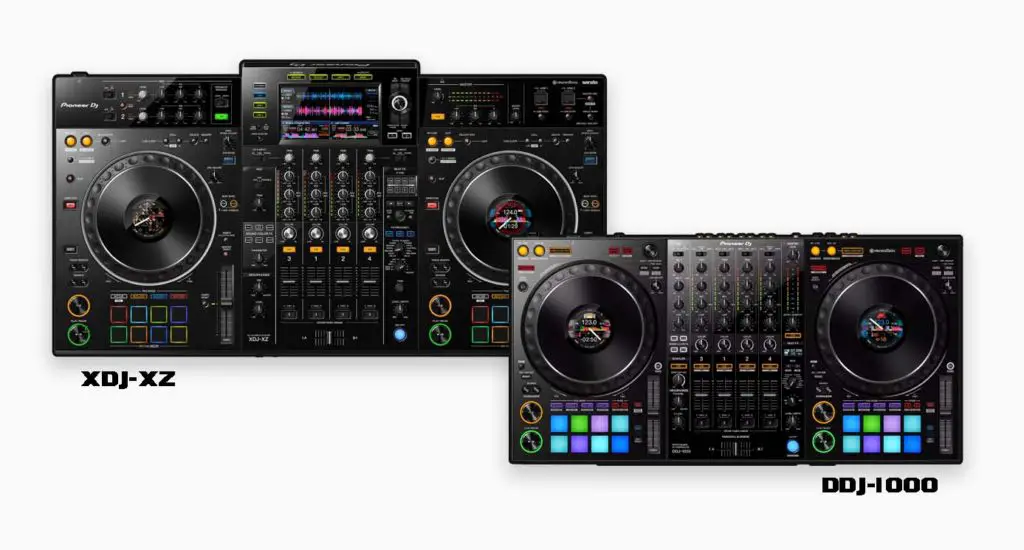
XDJ-XZ standalone mode
The XDJ-XZ can function in a standalone mode – that is you can use it without a laptop plugged into it, supplying your music on a USB storage device.
Keep in mind that while using the XDJ-XZ in standalone mode you can utilize only 2 decks at once. 2 additional decks are available once you connect your XDJ-XZ to a laptop and Rekordbox / Serato DJ software.
Once the XDJ-XZ is connected to a laptop with Rekordbox or Serato DJ software it can function as a standard DJ controller. When using the XDJ-XZ with your laptop more features become available that aren’t accessible in standalone mode (for example sampler pad mode, key sync, control over decks 3 and 4).
The DDJ-1000 can only be used with Rekordbox software on a laptop (or Serato DJ when we’re talking about the DDJ-1000SRT).
Weight and size
While the XDJ-XZ can be used without a laptop it’s also much bigger and heavier than the DDJ-1000. Here are the dimensions of the two controllers:
DDJ-1000:
- Width: 28″ (71 cm)
- Height: 3″ (8 cm)
- Depth: 14″ (35 cm)
XDJ-XZ:
- Width: 35″ (89 cm)
- Height: 5″ (13 cm)
- Depth: 18″ (46 cm)
[these are rounded dimensions from the official Pioneer DJ website – for exact measurements refer to the said website here: DDJ-1000, XDJ-XZ]
Additionally there is a great weight difference between the two: the DDJ-1000 weighs only about 12lb (6kg), when the XDJ-XZ weighs around 29lb (13kg) so more than twice as much.
The screen on the XDJ-XZ
The Pioneer XDJ-XZ features an 7-inch resistive LCD touchscreen that enables you to control the track playback on 2 decks at once, keep an eye on active Beat FX, cue points, loops and track information.
The track library controls are located around the screen to make the track selection process quick and efficient.

Because this is a resistive screen rather than a capacitive one, the device won’t let you make use of multi-touch functionality, on-screen gestures or smooth finger scrolling – things you would be able to do on a capacitive (smartphone-like) touch screen.
As DDJ-1000 is not a standalone device and it’s made to work solely with a laptop, it doesn’t feature an LCD screen besides the jog wheel displays that are made for mirroring track info from your DJ software.
Audio FX – effects section comparison
The XDJ-XZ and the DDJ-1000 both feature 14 Beat FX but the available effects differ between the two devices.
The Beat FX on the XDJ-XZ are the exact same audio effects that you would normally find on a DJM-900NXS2 mixer.
In the set of effects of the Pioneer DDJ-1000 you can find effects that aren’t present on the XDJ-XZ – that is: Low Cut Echo, Mobius Saw, Mobius Triangle and Enigma Jet. Because of the presence of those effects the DDJ-1000 lacks some effects that the XDJ-XZ has as both devices are limited to 14 Beat FX.
In the DDJ-1000 Beat FX section you won’t find the classic Filter, Delay, Vinyl Break and Helix effects that are present on the XDJ-XZ (although there is an MT delay present, and the filter is naturally accessible from the mixer knobs as a Sound Color effect).

An important difference is also the lack of an X-pad for additional touch control of FX parameters of the audio effects on the DDJ-1000. The XDJ-XZ has the touch X-pad built in.
Additionally on the XDJ-XZ you are able to control which frequency ranges will be affected by the chosen Beat FX using three dedicated buttons – you won’t find those on the DDJ-1000.
Both devices feature a knob that lets you control which audio channels will be affected by the Beat FX.
When it comes to Sound Color FX the XDJ-XZ features a full set of 6 Sound Color FX, while the DDJ-1000 only has 4 of these.
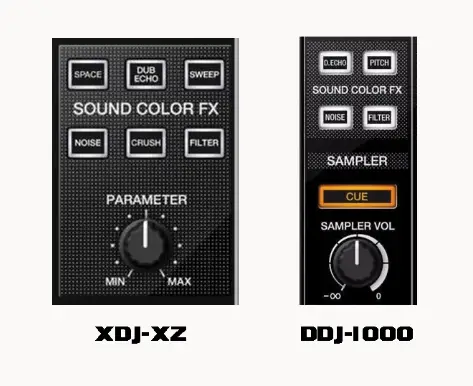
DDJ-1000 lacks the Crush, Sweep and Space FX in the Sound Color section. On the other hand you won’t find the Pitch effect on the XDJ-XZ while it’s present on the DDJ-1000.
There is a Sound Color parameter knob present on the XDJ-XZ that you won’t find on the DDJ-1000.
You can also find additional sampler controls beneath the Sound Color FX section of the DDJ-1000 as the device supports a sampler pad mode while the XDJ-XZ in standalone mode doesn’t feature a sampler. To use the sampler with the XDJ-XZ with limited controls you have to use the device with Rekordbox software in controller mode.
The mixer section and other differences
The mixer section on the XDJ-XZ closely resembles the mixer panel of the DJM-900NXS2 with its big silver Color FX/filter knobs.
The mixer layout on the DDJ-1000 is visually closer to a type of mixer that you might know from the early DDJ controller series.
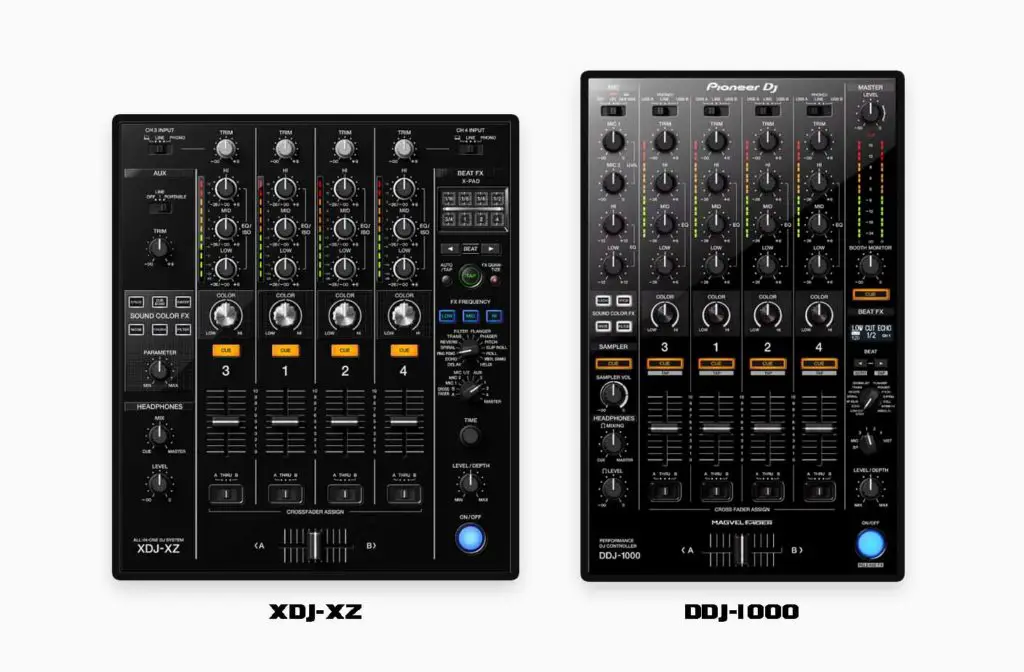
Pioneer XDJ-XZ also features the additional hardware control sections in the top part of the controller, from right to left: double microphone audio mixer and EQ with feedback reducer controls, the 7-inch LCD display and track selection controls, the master level and master EQ controls alongside with the USB storage devices input bay on the right hand side.
DDJ-1000 does not feature any of the sections mentioned above.
The XDJ-XZ does not feature key sync or key reset buttons on each deck near the pitch fader like the DDJ-1000 does and it doesn’t let you change the track’s key in standalone mode, although it lets you control the track’s key in the controller mode using the performance pad shortcuts.
New Pioneer XDJ-RX3 vs. XDJ-RX2 (Direct comparison)
The other important thing is, as we’ve pointed out before you can’t fully utilize all 4 mixer channels in standalone mode on the XDJ-XZ. If you’re not using the XDJ-XZ in the link mode with additional Pioneer CDJ players plugged in, or in the controller mode with your laptop, you can only use two channels for loading and playing tracks.
When using the XDJ-XZ in controller mode you will have to either switch the decks using the touch screen or on the newer firmware versions by double tapping the shift button as there are no dedicated deck changing buttons on the device.
DDJ-1000 on the other hand has a button on each deck that enables you to quickly change the decks from 3 to 1 and from 2 to 4.
The crossfader
The DDJ-1000 features a Magvel fader while the XDJ-XZ does not. This may be an important information for some scratch DJs out there although both of the devices are more than suitable for scratching.
The jog wheels
The jog wheels on both units are equally sized and they are both the same high quality full sized mechanical jog wheels that you can find on the CDJ2000NXS players.
The jog wheels on both devices feature LCD displays that are able to indicate which deck is currently active, if the sync or slip mode are on, you are able to see the tempo and key of the currently playing track and additionally there is simplified track waveform view present on top of each of the jog wheels.
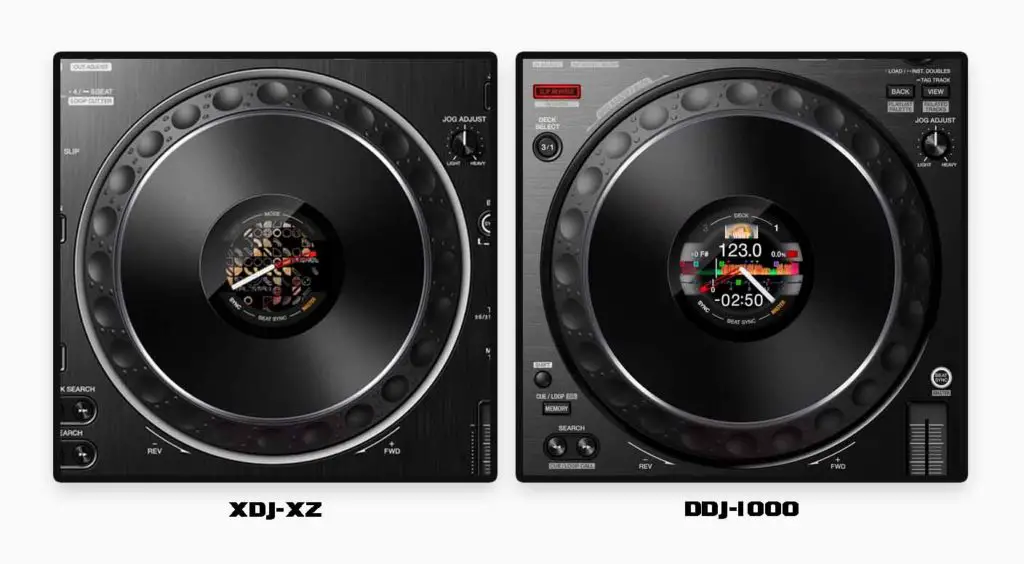
The tension of the jog wheels can be freely adjusted both on the DDJ-1000 and the XDJ-XZ using a knob present on each deck.
Performance pads
When it comes to the performance pads, besides the visual differences, one major thing here is that the XDJ-XZ in standalone mode does not let you control the sampler using the performance pads and therefore it does not feature dedicated sampler hardware controls.

The XDJ-XZ in standalone mode lets you use 4 pad modes: Hot Cue mode, Beat Loop mode (auto loops), Slip Loop mode (loop rolls) and Beat Jump (beat skipping).
When the XDJ-XZ is connected to a laptop with Rekordbox DJ software you can access a few additional performance pad modes – for example the Rekordbox pad FX mode or sampler mode.
Inputs & Outputs
Here we list all the inputs and outputs present on both devices (source: DDJ-1000, XDJ-XZ)
DDJ-1000:
| Inputs | – 2x LINE (RCA) – 2x PHONO/LINE (RCA) – 2x MIC (XLR & 1/4 inch TRS Jack) |
|---|---|
| USB | – 2x USB B ports |
| Outputs | – 2x MASTER (XLR, RCA) – 1x BOOTH (1/4 inch TRS Jack) – 2x PHONES (1/4-inch stereo jack, 1/8 inch stereo jack) |
XDJ-XZ:
| Inputs | – 2x LINE (RCA) – 2x PHONO (RCA) – 1x AUX (RCA) – 2x MIC (XLR & 1/4 inch TRS Jack) |
|---|---|
| LAN | – 3x (100Base TX) |
| USB | – 2x USB A ports – 1x USB B port |
| Outputs | – 2x MASTER (XLR, RCA) – 1x BOOTH (1/4 inch TRS Jack) – 2x PHONES (1/4-inch stereo jack, 1/8-inch stereo mini-jack) – 1x SEND (1/4 inch TRS Jack) |
The Pioneer XDJ-XZ features inputs only for channels 3 and 4, sadly there are no separate audio inputs for the channels 1 and 2 present on the device.
DDJ-1000 features separate audio inputs for all 4 mixer channels.
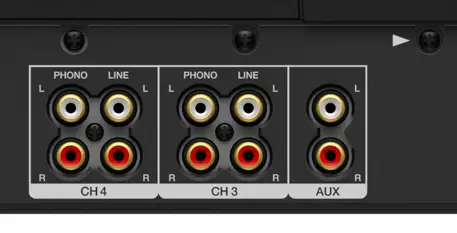
The DDJ-1000 also features two USB outputs so you are able to use this controller with two laptops (for example during back-to-back mixes). The XDJ-XZ has only one USB cable output on its back panel.

Another thing is the XDJ-XZ doesn’t need an external power supply as its got one already built in. This means that you only need a simple AC power cable to get it running. With the DDJ-1000 you have to use a power brick that comes with the device.
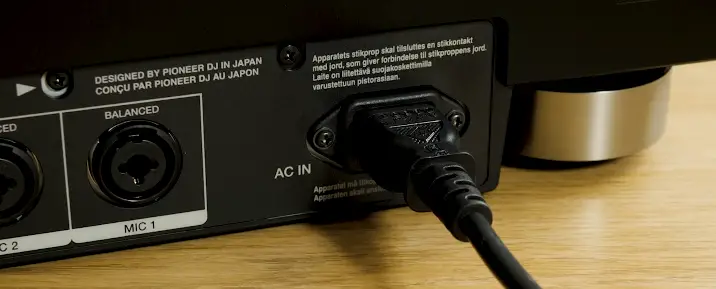
Software compatibility
The DDJ-1000 is natively a Rekordbox controller but it also has a separate Serato compatible version – the DDJ-1000SRT.
The XDJ-XZ is compatible both with Rekordbox and Serato DJ Pro software. The device also supports DVS, although you will need a separate license to unlock that functionality in Rekordbox.
DVS And Timecode For DJs Explained.
Aside from using the XDJ-XZ in standalone mode you can use it with a laptop in two modes:
- Export mode – here your laptop will simply function as a plugged in music storage device.
- Controller mode – this mode gives you full control over the Rekordbox or Serato DJ software.

Which one should you get?
Both the devices retain the feel of club standard CDJ setup however the XDJ-XZ has an advantage of being able to work without a laptop.
New Pioneer DDJ-Rev7 – DJ Controller Detailed Review
The major differences besides the 2 deck standalone functionality of the XDJ-XZ are: a slightly differing set of audio FX between the two, layout differences and sheer weight and size that almost put these devices in two different categories when it comes to transport.
If you’re still unsure about which device to aim for feel free to consult with our list of pros and cons of both devices that takes into consideration the most important differences between the two units:
-> Check out the DDJ-1000, DDJ-1000SRT and XDJ-XZ on Amazon here! <-
Pros and cons of both devices:
Pioneer DDJ-1000:

Pros:
- Compact size 4 channel DJ controller.
- Features a set of effects similar to these present on the DJM-900NXS2.
- Magvel fader onboard.
- Separate audio inputs for all 4 mixer channels.
- Has dedicated sampler controls.
- Features double USB inputs for back-to-back mixes.
Cons:
- You have to choose between the Rekordbox compatible model (DDJ-1000) and the Serato DJ compatible model (DDJ-1000SRT)
- Doesn’t feature the whole set of classic DJM-900NXS2 audio FX as the XDJ-XZ does.
| Pioneer DDJ-1000: |
Pioneer XDJ-XZ:

Pros:
- It can function in standalone mode.
- Ability to make use of the device’s screen even when using the device with a laptop in controller mode.
- The XDJ-XZ works with both Rekordbox and Serato DJ out of the box.
- Features a master EQ section.
- Gives you the ability to connect 2 additional Pioneer CDJ players and utilize all 4 decks with those (Pro DJ Link support).
- Features and X-pad for additional audio FX control.
- Has a power supply built in.
Cons:
- You can use only 2 of the 4 mixer channels for loading and playing tracks in standalone mode.
- Really bulky and twice as heavy as the DDJ-1000.
- No key-shift or key-sync functions in standalone mode.
- Separate audio inputs only for channels 3 and 4.
- No dedicated sampler controls on the device and no sampler functionality at all in standalone mode.
- Only a single USB cable input.
| Pioneer XDJ-XZ: |
You might also like: Numark Mixstream Pro – Full Gear Features Overview

